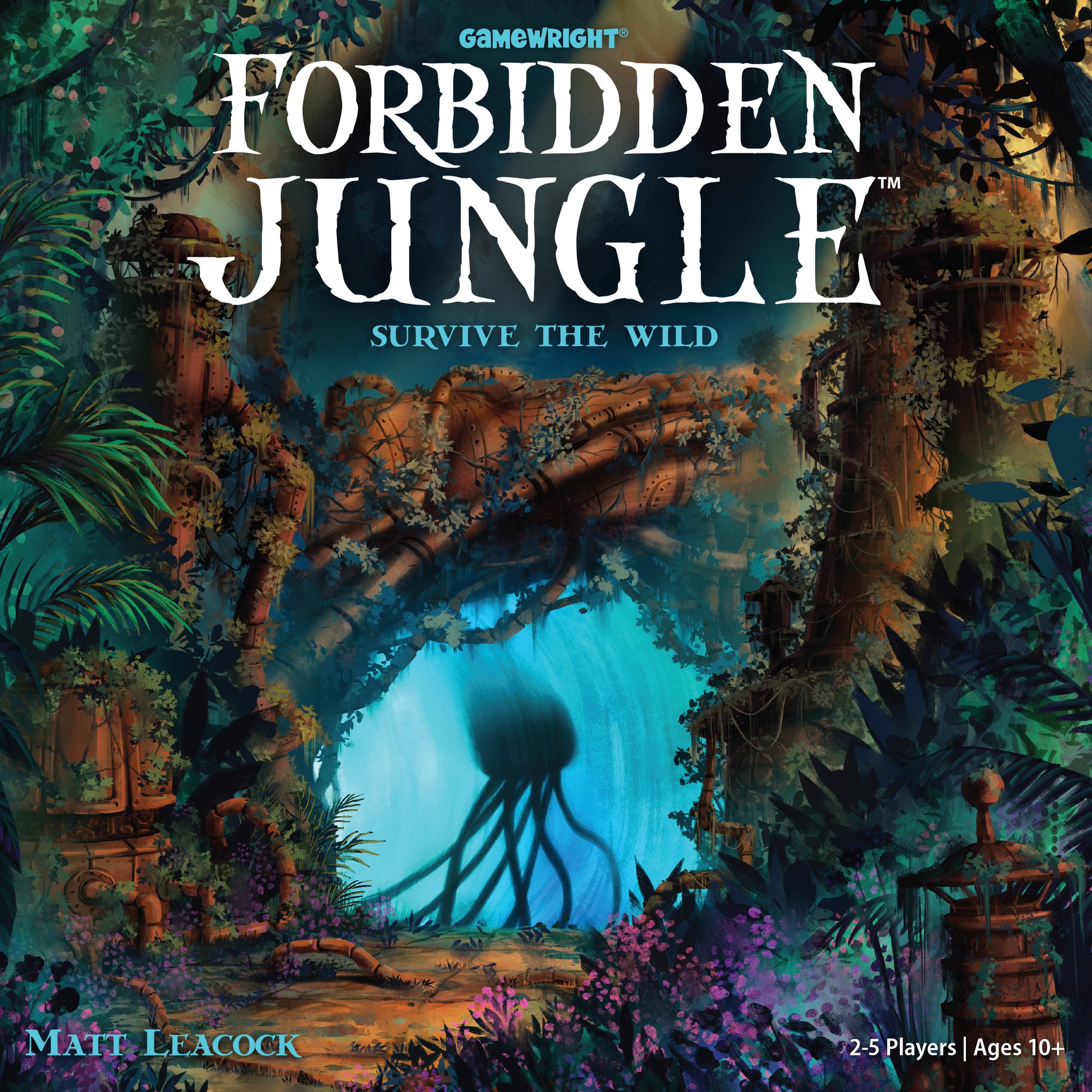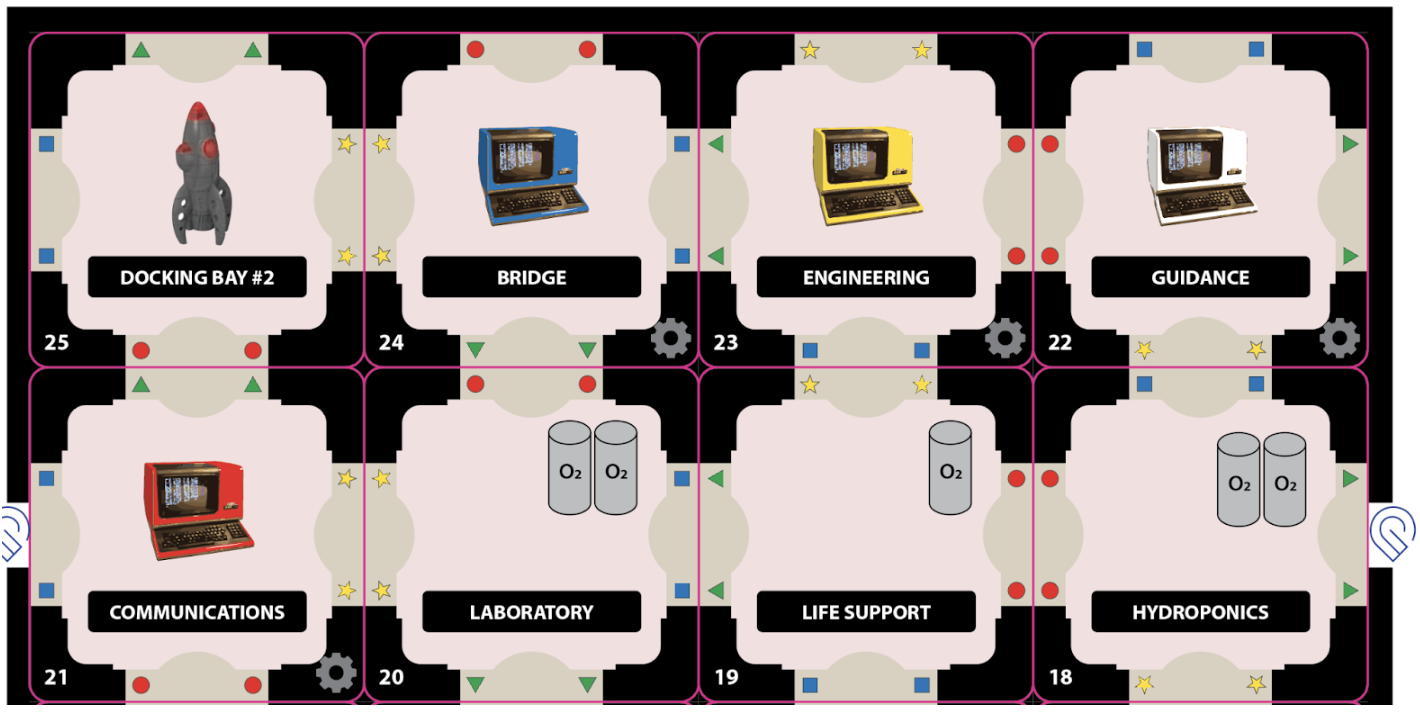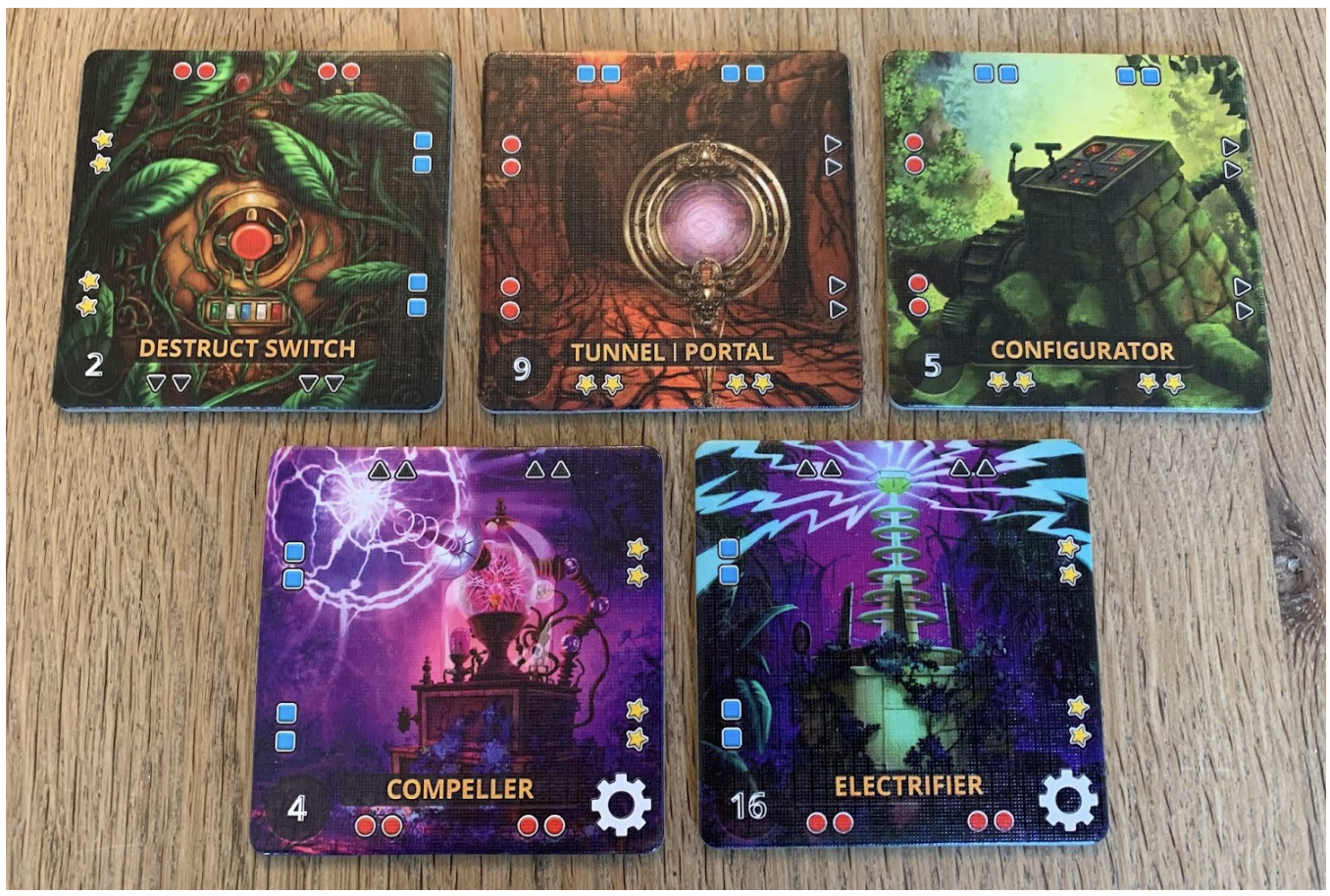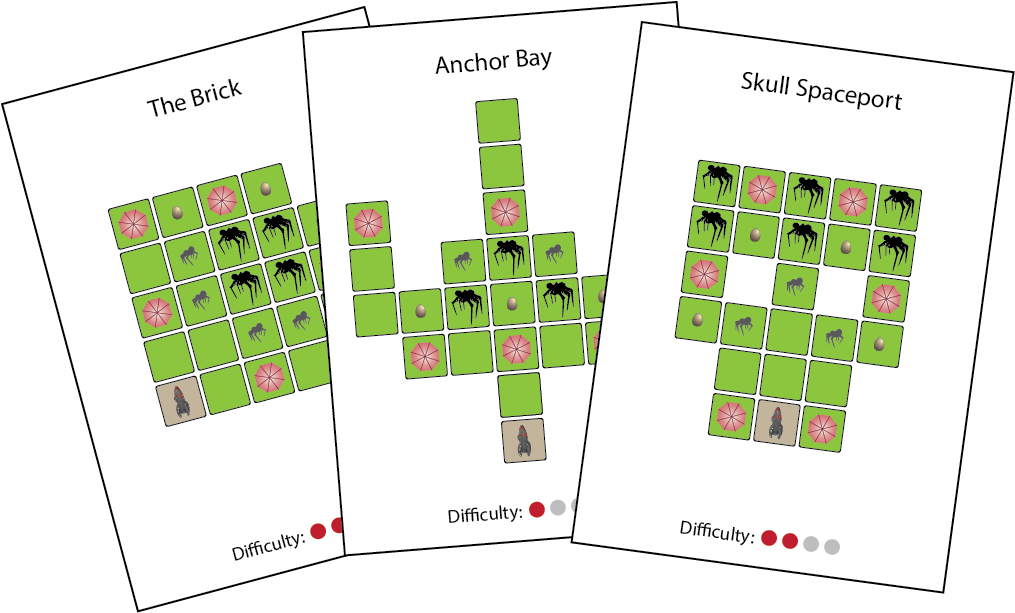After several years of design and development, Forbidden Jungle is finally here! In this diary, I’ll recount the search for the setting, some of the design challenges I faced, and look to what’s next.
The Setting
The adventurers lift off from Forbidden Island in their helicopter to later escape in a rebuilt airship in Forbidden Desert, then power a rocket to lift off in Forbidden Sky.
When I began the design of the fourth game in the Forbidden series, the first thing I tackled was its setting. Players had already encountered a sinking island, a perilous desert, and a mysterious power platform in the sky. What was next? I figured that since Forbidden Sky ends with the players taking off in a rocket, I should pursue an outer space setting. So my initial design had the adventurers dock their rocket at a space station that I populated with self-replicating maintenance robots. The players would need to explore the station, avoid the robots, and find some means of escape. I gave the new prototype the tentative name, “Forbidden Station.”
One problem: I hated the name. The setting felt too cold and clinical. And it didn’t seem to be in line with the line’s “adventure” genre.
A screen grab from a fairly early Forbidden Station prototype file (July 2021).
A screen grab from an early Forbidden Island prototype. Forbidden Island also began its life with a space theme.
Coincidentally, way back in 2009, I pitched the design that went on to become Forbidden Island also as a space game. In the first prototype, Asteroid Storm, the players were in a spaceship that had drifted into an asteroid field. They needed to gather up four pieces of equipment (space suits, food for the journey, a flight plan, and their alien artifact*) and make it to the escape pod before their ship was blown to pieces. During play, asteroids slammed into the ship, damaging it, and if damaged pieces were hit again, they were removed from play.
Because Gamewright wanted to avoid a space theme, we switched its setting to sinking island. The modules of the space station became different locations on a mythical island and the equipment to be gathered became treasures that the players would need to collect. CB Canga’s artwork brought the game to life and we all agreed that this story and setting was much stronger.
Forbidden Jungle saw a similar shift during development. I changed the space station into an abandoned spaceport on a remote moon, overcome by encroaching jungle (think: Yavin 4 from Star Wars). I changed the self-replicating robots into aliens that resembled spiders.
I found that using spiders had lots of advantages: they could be shown in various life stages: egg, hatchling, and adult, they could sting the adventurers, and they could spin webs to block tile exits. While the self-replicating robots functioned in similar ways (they came in small, medium, and large sizes, could zap adventurers, and spray hull-reinforcing, hardening foam to block the exits) they felt like much more of a stretch thematically. (I especially grew tired of explaining the idea behind the foam.) But the biggest reason I changed from station to jungle was how I imagined the setting would be brought to life in the game’s illustrations. An ancient spaceport, overrun by jungle and inhabited by spiders would result in much more pleasing and lush visuals compared to the (typically) sterile environment that a space station suggests. Jungle felt like a better fit.
Differentiation
I never want to add a title to a series unless it offers something new to it – so a player would consider owning every game in the line. Forbidden Island offers an easy onramp and features a rapidly shrinking board. Forbidden Desert ramps up the challenge and has players shifting the board around as the winds of the sandstorm dictate. Forbidden Sky has players exploring and building their board as they go. For me, the challenge for game #4 was, after shrinking, shifting, and building what’s next?
I ultimately answered this question by sampling a little bit from each of the earlier titles. As you play Forbidden Jungle, different tiles sink into sinkholes, shrinking the board like Forbidden Island. You explore the jungle, flipping tiles over to see what’s inside them and can shift them in a way that is similar to Forbidden Desert. And you must also assemble your escape route by arranging a portal next to four powered gems. This echoes how you power up the rocket in Forbidden Sky. There are callbacks in Jungle to each of the preceding titles.
The Antagonists
Instead of relying solely on the board to differentiate the game, I decided to focus on its antagonists. Forbidden Jungle is the first game in the series to feature baddies that are actively out to get you. In contrast, the other titles all feature environmental threats – rising water (threat of drowning), a blowing sandstorm (threats of exposure, dehydration, being buried alive), and a thunderstorm (threats of electrocution or falling from a great height). In Jungle, players must avoid being overrun or poisoned by the spiders.
I was especially drawn to having a stronger sense of an embodied threat on the board after seeing the reception of Forbidden Sky. Forbidden Sky has you constructing an elaborate – and functional! – electrical circuit to power your escape which is thrilling when you can accomplish it, but the antagonists in the game are quite abstract. You’re up against time, the threat of being struck by lightning, and the strength of your rope – none of which are shown on the board. You don’t get the visceral sense of an island rapidly shrinking to only a handful of tiles or sand accumulating into larger and larger dunes. With this new game, I wanted even casual observers to be able to glance at the game on the table and think: oh, wow, I can see that you’re all in a lot of danger!
But picking a baddie for a game targeted at kids and families can be a challenge. You don’t want to pick an antagonist that is too scary and yet, you don’t want the players to feel remorse after removing them. I was initially excited about the robots since they can be disassembled without too much fuss on the players’ part. But it turns out that creepy, dangerous, otherworldly spiders also felt like fair game – especially if they are aiming to sting or bite you.
The inspiration behind the three life stages of the spiders (egg, hatchling, and adult) came from Tom Wham’s classic game, The Awful Green Things from Outer Space which I played and loved in college and the movie Alien, both, coincidentally from 1979. (Though in this game, the hatchlings are relatively harmless, unlike the face-huggers of Alien.)
The Machines
With the threat well established, I wanted the players to have a robust set of options to consider while solving it. To that end, Forbidden Jungle offers a variety of machines that you can discover that unlock new abilities:
The Destruct Switch gives you the power to destroy a tile in the game – and everything on it – by spending a single action. Being able to blow up a tile full of spiders can feel incredibly powerful. You need to show some restraint though: if you blow up all of the portals (or any of the illuminated gems), you’ll find yourself without a way out.
The Configurator allows you to rearrange the space station’s tiles, moving them like a sliding puzzle. This has all sorts of uses: first, you can slide gems next to an escape portal to power it – but you can also slide tiles containing other adventurers to help them move or slide spiders closer to the Electrifier which works as a glorified bug zapper.
The Compeller lets you move a group of hatchlings and adults from one tile to another. This can be handy if they’re in your way, about to sting your friend. You can also move them into the Electrifier. Zap!
The Portal is about as simple a machine as you can get. It features one button. If you press it, you win the game! (Provided that everyone is assembled on the tile, it’s powered up, and there aren’t any aliens on the tile.)
These special tiles let me expand the range of options available to the players, widening out space of possible solutions, without dramatically increasing the complexity of the overall game.
Samples of the machines from a printer’s proof. (Images may change slightly in the final game)
Design Challenges
Managing Tension
Maintaining the spider population proved to be one of the thorniest design challenges. Early versions of the game relied solely on the threat cards that managed the life cycles of the spiders. These cards have the adults lay eggs, turn eggs into hatchlings, and turn hatchlings into adults (who can then lay more eggs). This worked great, except that if the players managed to clear the board of spiders, their population would crash, bottoming out most of the tension for the remainder of the game. To solve this, I supplemented the life cycle cards with three new cards that have adults emerging from the portals, hatchlings emerging from the tunnels, and eggs being discovered in nests. With this design, as you explore more and more of the board, more portals, tunnels, and nests appear and the danger increases in parallel.
These six cards increase the population of spiders in the jungle. Early prototypes only used the first three cards. The last three cards ramp up the tension of the game as more and more of the jungle is explored.
Doubling Down on Fun
In playtesting, players found blowing up tiles felt incredibly satisfying. Early prototypes had only a single piece of equipment (Explosives) that let you remove a tile adjacent to your adventurer. To give players more opportunities to blow stuff up, I added the Destruct Switch… and then a second Destruct Switch! These tiles not only let you blow up spiders, but also allow you to remove tiles that may be in the way of completing the puzzle.
Eliminating Grind
Early prototypes featured “Computers” that could only shift a tile up/down or left/right. In testing, these felt quite grindy. You’d need to move to one computer, operate it to move tiles in one direction, then run to a different computer, and operate it to move it in another direction, and so on. The Configurators in the final version of the game let you feel much more powerful—you can choose any direction: up, down, left, or right, then move the tile any number of spaces in that direction.
Forbidden Station also had players managing their oxygen levels like water in Forbidden Desert. This was a bit too similar to Desert, felt mostly like work, and since the game already had plenty of other problems to juggle, I was happy to ditch it.
Designing the Alien Figures
It took a bunch of iterations to nail the figures down. The adults had to be scary but not too scary. (Some early versions were quite goofy looking.) The final adults are quite tall which let them have long, scary legs without taking up too much space on a tile. I specified little nubs on the ridges of the hatchlings so they’d be easier to pick up off the tiles. And getting the small/medium/large proportions just right was surprisingly difficult. The illustrator, C.B. Canga specified a color palette for them which helped them coordinate with his illustrations while feeling otherworldly.
A partial evolution of the adult spider. As they evolved, the adults lost their goofy grin, collar, and stinger and grew sharp teeth. The left two figures are from .stls found on the web and were used for inspiration. The Sculpey one was made by my daughter Anna as part of an experiment exploring scale.
Early (left) and final (right) aliens: adult, hatchling, and egg. I had the sculptor add nubs to the edges of the hatchling so they’d be easier to pick up. The most important change here was a sense of large/medium/small scale. In the original metal comps the hatchling looks smaller than the egg!
Replay and Variability
In response to all the enthusiasm for the variable island layouts that were first featured in the German edition of the Forbidden Island, I included six different spaceport designs with Forbidden Jungle so that you can try your hand at each one of them. Their design was a bit counter-intuitive – denser spaceport layouts were actually harder to play since the tiles have fewer degrees of movement.
To ensure variety and challenge, your next game can feature a different mix of adventurers, explored machines, equipment cards, random tile arrangement, along with a different spaceport design and/or difficulty setting.
Beyond the Portal
Different space station layouts add variety to the game.
If and when the adventurers escape, what lies beyond the portal? Will they ever find the Archeans? I’d love to hear your theories!
*I was able to realize a similar objective in Space Escape (formerly Mole Rats in Space), except that the alien artifact became a toothbrush, along with a few other tweaks. They both featured duct tape.









